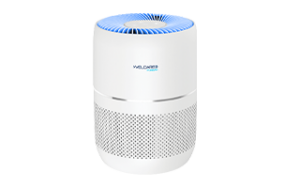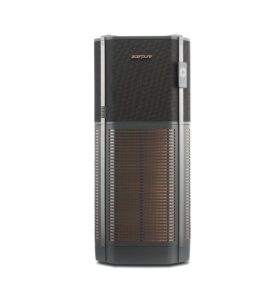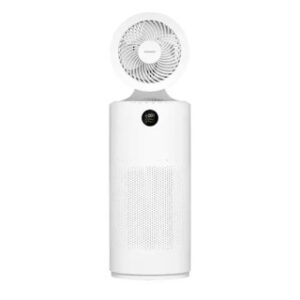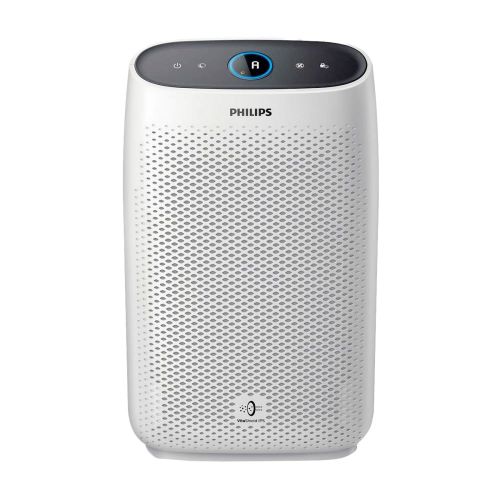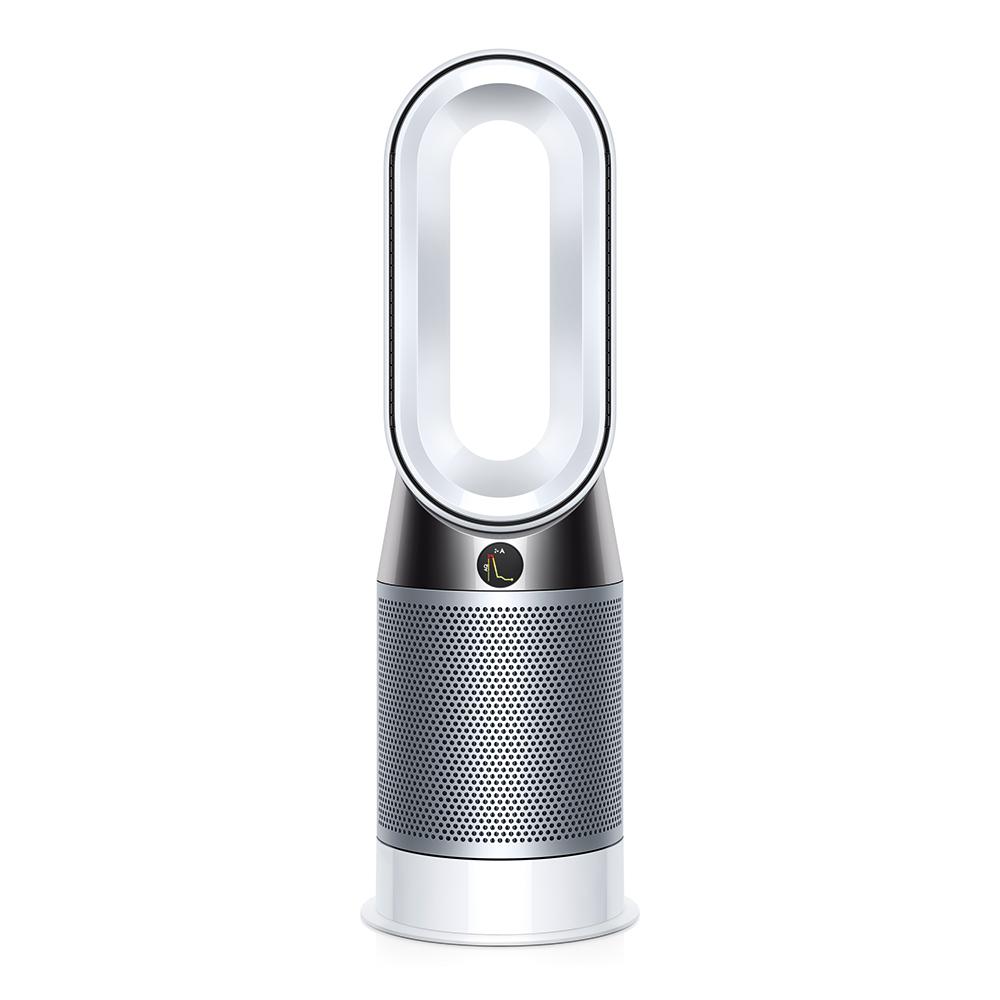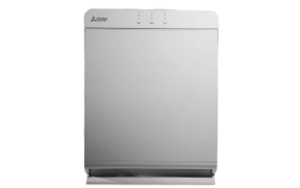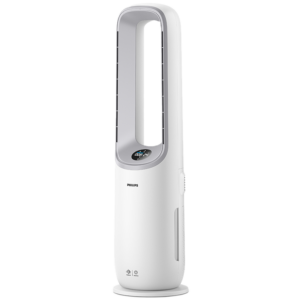You’re going to need a bigger desk.
Welcare PureAir Desktop Air Purifier review
At a time when air purifiers are more sought after than ever, a huge responsibility has landed on the shoulders of manufacturers to navigate the turbulent environment with practical solutions for the average household. For better or worse, companies like Samsung have responded to the growing climate emergency with smart technologies that cater to Australia’s unique weather conditions. But it’s still an evolving market, as evidenced by the technologically basic offering of the Welcare Desktop Air Purifier; a trusty apocalypse companion without all the bells and whistles required for a full-blown dystopian future.
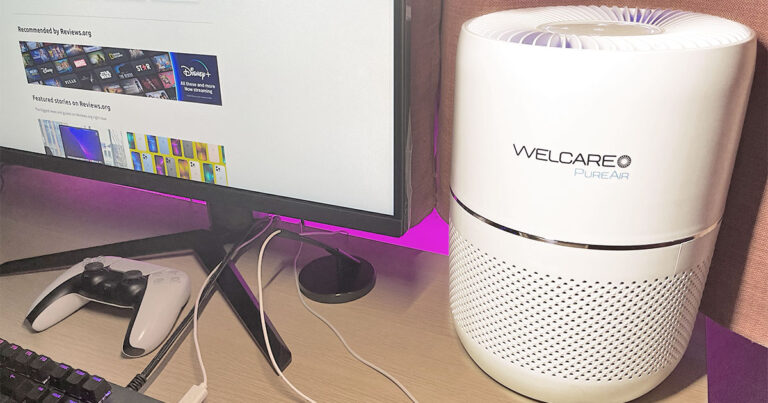
How much does the Welcare PureAir Desktop Air Purifier cost in Australia?
The Welcare Desktop Air Purifier retails at a modest $199.95. To be frank, its price tag is by far the Welcare Purifier’s most attractive feature. Air purifiers rarely come in below the $300 mark and if it weren’t for the fact that the Philips Series 1000 Air Purifier (our top pick) typically costs between $270 and $300, the Welcare Desktop Air Purifier would be easy to recommend for those who are fresh to the purifier party.
How much are replacement filters?
Another important question to ask when it comes to the ongoing affordability of any air purifier is how much do replacement filters cost? Depending on the workload, filters will typically need to be replaced every three to six months so expensive filters can change the overall value entirely. Thankfully, at $29.95 a pop the 3-in-1 HEPA13 filter replacements for the Welcare Desktop Air Purifier are about half the price of what we’ve come to expect from bigger brands. For comparison, the Philips Series 1000 has two filters that need replacing, the carbon pre-filter ($54.95) and HEPA filter ($74.95), which can become costly. So the cheaper all-in-one solution offered by Welcare is much appreciated.
The one issue is a question of availability. Currently, Welcare filter replacements are only available via the official website, whereas other brands like Philips and Samsung sell their filters online and through physical retailers like Harvey Norman and The Good Guys.
Welcare Desktop Air Purifier coverage and performance
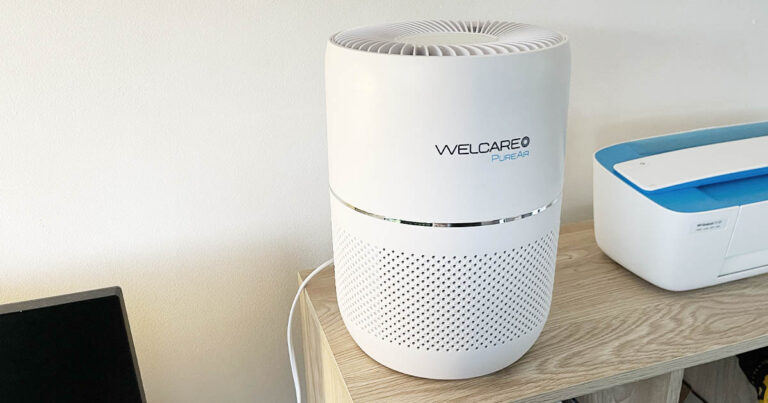
Let’s clear the air and get cut straight to the point, if you’re a fan of the Welcare Desktop Air Purifier’s cheaper price, you need to understand you’re compromising on room coverage. Most air purifiers we’ve compared cover areas of around 60m2 but the Welcare Desktop Air Purifier only promises 12.36m2 of coverage. Keeping it in a larger room will still help clear some airborne nasties but it works most efficiently in smaller spaces. That’s probably to be expected from a desktop model, something suited to smaller home offices but for larger living areas you might be better off spending extra on something like Samsung’s AX5500 Air Purifier or the Philips Series 1000 Air Purifier.
Anecdotally, I’ve used the Welcare Air Purifier in a small home office and beside my bed in a much larger room. With two cats in the house, air purifiers have their work cut out for them in this house. The Welcare Desktop Air Purifier hasn’t significantly reduced the amount of dust in my bedroom as other air purifiers have in the past, but one look at the inside filter is proof enough that it’s still capturing a good amount of dust, even in larger areas.
But the fact remains that the Welcare Desktop Air Purifier’s smaller size means it will have a lower CADR (Clean Air Delivery Rate) than bigger units. It’s mostly a matter of surface area; a filter with a larger surface area with comparable fan power will naturally remove more particles from the air. CADR isn’t the be-all-end-all of an air purifier’s performance, but it’s a useful metric to help compare air purifiers.
The Welcare Desktop Air Purifier has a CADR of 103m3/h, whereas Welcare’s larger PureAir Household Air Purifier has a CADR of 310m3/h. But the Welcare Desktop Air Purifier only weighs 2.5kg, whereas the Household Air Purifier weighs a hefty 8.6kg. So really, the Welcare Desktop Air Purifier’s performance is decent for its size.
That performance comes at a price, however. Even compared to much larger purifiers, the little Welcare Desktop Air Purifier can generate noise levels up to 55 decibels, which isn’t much quieter than the Welcare PureAir Household Air Purifier’s max output of 60 decibels. In short, the Welcare Desktop Air Purifier makes quite a racket for such a small appliance.
Friendly user experience even without the smarts
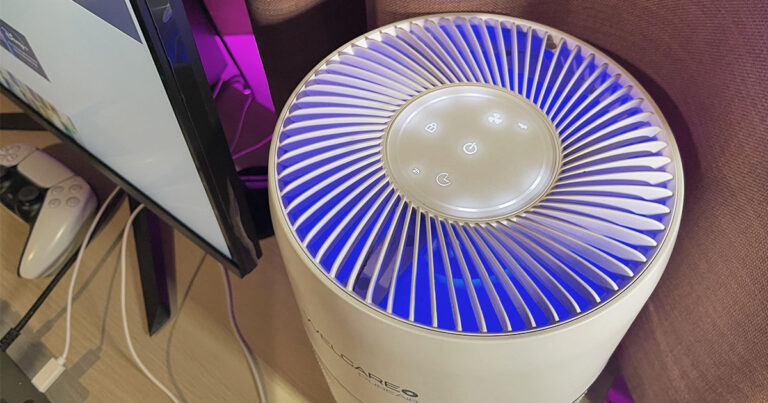
The other downside to the Welcare Desktop Air Purifier is its lack of smarts. It’s not an outlier by any measure. Many of our best picks are lacking any kind of internet connectivity; it’s a product category that’s still catching up with the times. Samsung’s range of air purifiers is probably doing it best but even they have limited smart features. Still, the Welcare Desktop Air Purifier is so simple to use, that you basically can’t mess it up. Some of the icons could be a little more descriptive (like the multi-function menu button that flashes when it’s time to replace your filters). But the colour-coded PM2.5 air quality indicator is fairly intuitive; Blue is Perfect (0-50), Green is Good (50-100), Purple is Normal (100-150) and Red is Bad (150+).
It’s plug-and-play, replacing filters is simple and stress-free, and it has all the basic functions (fan speed, sleep timer and child-lock).
Timers, night mode and aromatherapy functions
As mentioned, the Welcare Desktop Air Purifier has all the regular features you’d expect with nothing major missing from the suite. But the standout feature is surely the included aromatherapy sponges. At the base of the air purifier, there are two sponges in place that you can dab with your essential oil of choice, adding an aromatic twist to your air purifier experience. And you know what? It’s surprisingly effective as a diffuser. Even when I do have it sitting on my desk, less than a metre from my face, the lavender emanating from its sponges isn’t overpowering in the slightest. Some might prefer a stronger diffuser, but I appreciate the subtle whiff of lavender in the air.
It’s plug-and-play, replacing filters is simple and stress-free, and it has all the basic functions (fan speed, sleep timer and child-lock).
Conclusion: Is the Welcare Desktop Air Purifier worth buying?
Far from the air-purifying powerhouses we’ve reviewed in the past, Welcare’s Desktop Air Purifier is a little too big for its proposed use case but also not powerful enough to provide adequate coverage in any room larger than a small home office. But it's a tough market for smaller purifiers, a huge part of their performance comes down to the surface area of their filters (bigger filters can, of course, capture more dust).
For the compact size and cheaper price, the Welcare PureAir Desktop Air Purifier is well-worth checking out, especially for those in smaller apartments or working from home in compact office spaces.
How we rate the best air purifiers in Australia
We’ve reviewed several air purifiers already but to cover the scope of what’s available out there, we analysed the price, coverage, HEPA filter efficiency, filter replacement cost and availability, alongside less important nice-to-have features, such as app control, and scheduling.
If a manufacturer wasn’t transparent enough with its testing and filtering efficiency, they were removed from the list.
We also removed all products that used meaningless marketing jargon, such as 'HEPA-type', 'HEPA-like' and any 'Permanent HEPA' brand that didn’t require filter replacements. Manufacturers also lost marks if they didn’t specify coverage size (an important consideration). Air purifiers that were transparent about their PM2.5 filtering and CADR (clean air delivery rate) were also given bonus points.
We disregarded any product where there was a conflict of information (e.g. products that make simultaneous claims of 'HEPA' and 'EPA' filtering or mixed messaging on coverage).
We’ve also removed products that aren’t currently available in Australia, such as the Rabbit Air MinusA2.
Lastly, we removed manufacturers that didn’t provide enough information about replacement filters. For example, the TruSens range, which is stocked by JB HI-FI doesn’t list any information on filter replacement pricing and when we got in touch with the customer care centre, we were told to get in touch with a local reseller. JB HI-FI also doesn’t stock replacement filters on its website.
Overall, that left us with a small list of options for air purifiers available in Australia.
Frequently asked questions about air purifiers
Yes. An air purifier that uses both HEPA filtering for fine particles and a pre-filter for larger particles might be your best defence against dangerous smoke levels in the home.
HEPA filters can catch particles as small as 0.3 micrometres with 99.97% efficiency, which covers most airborne toxins and allergens. They will do a reasonable job of catching larger nasties too. However, for the most efficient filtering of smoke particles (measuring at 2.5 micrometres or PM2.5), a combination of HEPA and pre-filtering is most efficient.
For example, the Philips and Samsung range of purifiers use an Active Carbon pre-filter that can catch gases and other TVOCS (Total Volatile Organic Compounds).
Some air purifiers (such as Samsung's AX5500 Air Purifier), are even specifically designed to give you a PM2.5 readout so you can tell exactly how much smoke’s managed to creep its way into your house.
Air purifiers are not a panacea for all your air pollutant problems and for people living with allergies or respiratory conditions like asthma, the 0.03% of particles that slip through can do some damage. Read on for more tips on keeping your house allergen and smoke-free.
HEPA, or High-Efficiency Particulate Air, grading is the measurement standard for air filtering. HEPA filters are often used in medical settings to minimise the risk of spreading airborne viruses and bacteria. Usually, medical-grade HEPA filters are used in conjunction with anti-microbial UV (ultraviolet) filters that eliminate bacteria and viruses caught by the HEPA filter.
HEPA filters are also commonly used in high-quality vacuum cleaners for the same purposes, trapping finer particles instead of kicking them into the air.
There are plenty of air purifier solutions that claim to have HEPA-graded filtering. However, since there is no regulatory authority that monitors the claims made by air purifier manufacturers. This makes buying an efficient air purifier difficult as many domestic solutions use “HEPA-like” filters that don’t adhere to the medical grading system.
Others claim to use HEPA grade filtering but fail to offer more crucial information, like the filtering efficiency and coverage. Others simply don’t offer any kind of pre-filtering for larger particles such as smoke.
The short answer? You don’t clean a HEPA filter. While some brands claim to have washable HEPA filters, your best bet will always be to replace your HEPA filter. We realise that sounds incredibly wasteful and expensive but washing HEPA filters disintegrates the ultra-fine fibres that catch all the dust and air pollution so you can’t count on the 99.97% efficiency.
This is especially pertinent if you’re using an air purifier for medical purposes. Washing a filter could put you at risk.
If the indicator on your air purifier is telling you it’s time for a replacement and you don’t have a spare filter on hand, you can try cleaning the air purity sensor with a cotton tip or, if you must, giving the filter a light vacuum with a soft brush head.
Certain brands have set (and publicly available) sustainability goals. For example, most Philips air purifiers are made with over 90% recycled materials.
Related Articles



